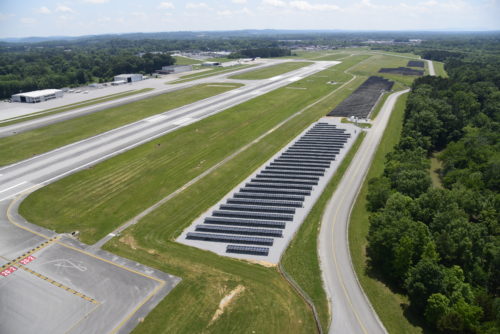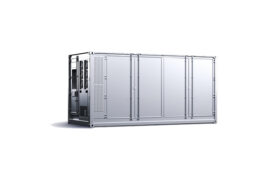The Chattanooga Metropolitan Airport is an anomaly in American aviation. The airport has taken environmentally conscious steps to all new major developments — from recycling windowpanes and repurposing them into countertops to “rubble-izing” concrete facilities and using the material as the groundwork for a 2.74-MW ground-mount solar array, which powers all its operations.
“We figure, we’re going to produce everything we could possibly use,” said John Naylor, former VP of planning and development for the Chattanooga Metropolitan Airport (CHA). “That’s how we got to today. Solar was just part of our sustainability program, part of the airport’s business model.”

KDC Solar installed a 2.74-MW solar system along the tarmac at Chattanooga Metropolitan Airport.
Naylor joined CHA’s staff in 2007 and was tasked with cutting the airport’s utility bill, its largest expense. Before any panels were installed at CHA, he decreased energy usage through updated, high-efficiency HVAC systems and lighting.
After getting the go-ahead from the airport president and securing grant funding, solar panels were first installed at CHA in 2011. Eight years later, the final phase of the array came online.
Construction
Inman Solar of Atlanta, Georgia, won a bidding process not once, not twice, but three times to engineer and construct the three-phase solar array at CHA. The company beat both international and domestic installers to make the Tennessee airport the first fully powered by PV solar in the United States.
The three phases of the solar project took place in 2011, 2012 and 2018, with full completion in April 2019. The solar system is comprised of three individual arrays installed in succession at the western end of the airport, each using different solar components in what was previously undeveloped land running parallel to the runways.
Inman Solar had a laundry list of stipulations to follow during construction since the entire solar system is on airport property. The site of the solar system was previously used as a flood plain and for backfill from other airport construction projects and was unfit for anything related to aviation.
“There was just land available inside security fences and you really couldn’t build a building there,” said Mark Jones, principal and co-founder of Inman Solar. “You can’t do anything there, but you can build solar because it’s low enough to the ground. It was not an obstruction.”
The Federal Aviation Administration requires that anything built near a runway must be 400 ft away from the centerline of the landing strip and remain under a certain height requirement. Luckily, ground-mounted solar panels fit the bill.
“The way the solar panels sit — just under 10 ft off the ground — they were just about the only thing that could fit in this area,” said Jack McAfee, current VP of planning and development at CHA.
Inman Solar was working in new territory and had to conduct studies during Phase 1 to determine if reflected light from the solar panels could be distracting for airplane pilots. Jones said the glare from the panels is approximately equal to that from light reflected on a lake or pond — not enough to be a concern for pilots. The greater concern would be solar panels reflecting light onto the control tower.

The solar arrays at Chattanooga Metropolitan Airport were installed in three phases over starting in 2007. The third and final project came online in 2019.
“We were sort of the guinea pig to figure all that out and did some elaborate reports where we showed that it wouldn’t bother them,” Jones said. “Everything in the Chattanooga Airport is installed south of the control tower, so it’s never possible for it to cause a problem for the control tower.”
Being in a high-security area like an airport meant Inman installers were getting daily clearance into the fenced-in worksite. Installers had to keep debris contained to ensure flights weren’t obstructed.
Phase 1 of the solar system, totaling 1 MW, uses Suniva panels, Solar FlexRack fixed-tilt racking and two Advanced Energy central inverters. Phase 2 at 1.1 MW also uses Suniva panels and Advanced Energy inverters but instead has RBI Solar fixed-tilt racking. Phase 3 uses 72-cell Heliene panels, RBI fixed-tilt racking and eight Solectria string inverters, totaling 641 kW of output.
Local utility EPB also installed an NEC Energy Solutions battery system during Phase 3 construction that will provide some emergency backup power. The DSS Distributed Energy Storage platform consists of two 280-kW/255-kWh lithium-ion batteries. While the array is grid-tied, the storage system will act as a backup microgrid, powering the airport and parts of the surrounding community during power outages.
“I think it shows, assuming you have enough landmass available, you can produce as much power as you consume or more, utilizing areas in it,” Jones said. “I think it’s quite a statement for the city of Chattanooga, having leapfrogged into being a clean energy leader.”
America’s most polluted
The Chattanooga Valley has a checkered past with sustainability. It was ranked the most polluted city in the United States in 1969. The region was home to many industries, railroads and coal furnaces, and the pollutants from unregulated emissions that settled into the Chattanooga Valley were so significant that residents experienced higher rates of pollution-related illness than the rest of the country. Naylor said the smog was so dense that you couldn’t see across the street.
However, following the report, Chattanooga passed legislation that worked to reverse the effects unregulated emissions had on the region.
“We actually passed a local pollution ordinance before the EPA came into existence the next year,” said Jed Marston, VP of marketing for EPB, the city’s electrical distributor. “Within the next four years, we were being recognized as a national model for cleaning up air pollution.”

Since then, the region has kept a check on local businesses and made regular ecological improvements. CHA is just another example of corporations committing to renewables in the area.
The approximately $10 million solar portfolio at CHA was funded through grants, the first phase through the Voluntary Airport Low Emissions Program Grant, and the next two through the FAA Section 512 Energy Efficiency Grant.
“CHA was the first airport to create as much energy as it consumed, so that’s a large statement,” McAfee said. “We are confined to our space, between a major roadway and a stream, so we don’t have any room to expand — yet we managed to find the space to build a solar farm. There are many other airports out there who have much more space than we do, so we hope to have set a positive example for all airports that they too can overstep obstacles to be more sustainable.”
CHA is a Class C airport with five gates and a single concourse. More than 500,000 people flew out of the airport in 2018, making it fourth in Tennessee for flights, and almost doubling its numbers prior to implementing its sustainability plan. A kiosk at the airport entrance displays the solar system’s current and lifetime production values by kilowatts and gigawatt-hours, and also shows equivalencies for trees planted and water and natural gas saved.
McAfee said the reduced utility costs from the solar system have allowed for lower parking fees and airfares for travelers.
“You keep it growing. You keep doing it,” Naylor said. “The biggest thing I tell everybody is you start small and do what you can do, and when you save money, you reinvest it in bigger and bigger projects until you’re where you want to be.”





““We actually passed a local pollution ordinance before the EPA came into existence the next year,” said Jed Marston, VP of marketing for EPB, the city’s electrical distributor. “Within the next four years, we were being recognized as a national model for cleaning up air pollution.””
Motto of the story: Public will can overcome obstacles without “bureaucracies”. Smack, EPA, oh how’s that problem with lead in the water in Flint Michigan going?